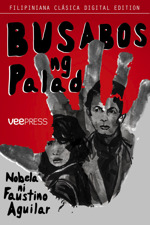
Tagalog is an Austronesian language spoken as a first language by the ethnic Tagalog people, who make up a quarter of the population of the Philippines, and as a second language by the majority. Its standardized form, officially named Filipino, is the national language of the Philippines, and is one of two official languages, alongside English.

"Bayan Ko" is one of the most recognizable patriotic songs of the Philippines. It was written in Spanish by the Revolutionary general José Alejandrino in light of the Philippine–American War and subsequent American occupation, and translated into Tagalog some three decades later by the poet José Corazón de Jesús.
Soledad Sarmiento Reyes is a Philippine literature scholar, literary and art critic, author, anthologist, consultant, professor, instructor, editor, annotator, researcher, and essayist in the Philippines. Specializing in the field of popular culture and the arts in the Philippines, Reyes is a professor teaching interdisciplinary studies at the University of the Philippines and the Ateneo de Manila University. She is an accomplished author of books and anthologies. "sa nobela mababalatuba ang mga pangyayati sa buhay ng isang kagawad sa union

Pinaglahuan is a Tagalog-language novel written by Filipino novelist Faustino S. Aguilar. Aguilar completed the manuscript on September 25, 1906. The novel was published by Manila Filateco in Manila, Philippines in 1907. The novel was written during the American period in Philippine history (1898-1946).
Faustino S. Aguilar is a pioneering Filipino novelist, journalist, revolutionary, union leader, and editor. Faustino was one of the first novelists in the Philippines to explore and present social realism through literature.
Ang Mestisa is a well-known Tagalog-language novel written by Filipino novelist Engracio L. Valmonte in 1920. Published in two parts, the novel was divided into two books entitled Ang Mestisa Unang Bahagi and Ang Mestisa Ikalawang Bahagi. The novel was published in Manila, Philippines by the Imprenta Ilagan y Compañia in 1921. It was printed by the Imprenta Nacional during the American period in Philippine history. Later on, the novel was adapted as a zarzuela.
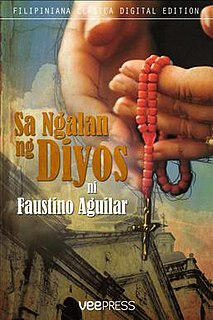
Sa Ngalan ng Diyos is a Tagalog-language novel written in 1911 by Filipino author Faustino Aguilar. Controversially, it illustrated how greedy Jesuit priests schemed, manipulated, and took advantage of Carmen, a young, naive, pious, and affluent heiress. The 191-page book was published in Manila by the Limbagan at Aklatan Ni I.R. Morales during the American period in Philippine history (1898–1946).
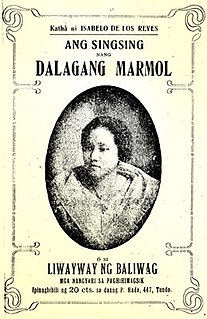
Ang Singsing nang Dalagang Marmol, contemporarily rendered as Ang Singsing ng Dalagang Marmol in the Tagalog language, is a historical novel written by Filipino novelist, scholar, and labor leader Isabelo Florentino de los Reyes before 1905. It is one of the first historical novels written in the Philippines during the first decade of the 20th century. It was also one of the first novels during the period that was written using the technique of blending fact and fiction. Through the novel, De los Reyes revealed his knowledge of the actual events during the Philippine–American War, making the subject as "integral elements" of the book. Based on the original 1912 bookcover for the novel, Ang Singsing ng Dalagang Marmol is alternatively titled Si Liwayway ng Baliwag.
Ang Anak ng Dumalaga is a Tagalog-language novel written by Filipino novelist Iñigo Ed. Regalado. It was published in 1933 in Manila, Philippines by the Limbagan Ilagan at Sanga during the American period in Philippine history (1898-1946). Ang Anak ng Dumalaga was one of the novels Regalado had written during the Golden Age of the Tagalog Novel.
Ang Huling Pagluha was the first novel of Filipino novelist Iñigo Ed. Regalado that appeared on the pages of the Tagalog-language magazine Liwayway. It began as a serial novel in Liwayway on 30 June 1926. The 283-page book version was published in 1933 in Manila, Philippines by the Bahay Aklatan "Ang Pagsilang" during the American era in Philippine history (1898-1946). Ang Huling Pagluha was one of the novels Regalado had written during the Golden Age of the Tagalog Novel (1905-1935).
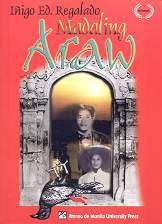
Madaling Araw ("Dawn") is a 1909 Tagalog-language novel written by Filipino novelist Iñigo Ed. Regalado. The 368-page novel was published in Manila, Philippines by the Aklatang J. Martinez during the American period in Philippine history (1899-1946). Madaling Araw won for Regalado a Panitikan Series Philippine National Book Award. The novel is both a romance novel and a political novel.
Patricio Geronimo Mariano was a Filipino nationalist, revolutionary, pundit, poet, playwright, dramatist, short story writer, novelist, journalist, violinist, and painter. Mariano was a Katipunan member. Mariano was the son of Petronilo Mariano and Dionisia Geronimo.
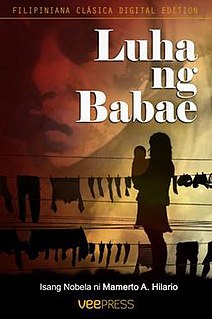
Luha ng Babae is a 1913 Tagalog-language novel written by Filipino novelist Mamerto A. Hilario. The 121-page book was published by the Limbagang Magiting Ni Honorio Lopez in Manila, Philippines during the American period in Philippine history. The 1913 edition of the book has a foreword written by Pascual de Leon.

Juan Masili: Ang Pinuno ng Tulisan is a 1906 Tagalog-language novel written by Filipino novelist Patricio Mariano. Based on Project Gutenberg, the original format of the title of the novel was rendered as Juan Masili o Ang Pinuno ng Tulisan meaning "Juan Masili or The Leader of Bandits", therefore the title could stand alone either as Juan Masili or as Ang Pinuno ng Tulisan. The 24-page short novel was published in Manila, Philippines by Libreria Luzonica during the American era in Philippine history.
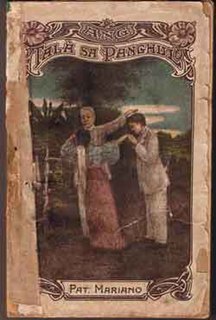
Ang Tala sa Panghulo is a 1913 Tagalog-language romance novel written by Filipino novelist Patricio Mariano. The 207-page book was published in Manila by R. Martinez and was printed by the Imprenta at Litograpya Ni Juan Fajardo during the American era in Philippine history. The novel is alternatively known as Ang Tala sa Panghulo: Nobelang Taga-ilog, which can also mean Ang Tala sa Panghulo: Nobelang Tagalog, thus the alternative English translation is The Bright Star at Panghulo: A Tagalog Novel.
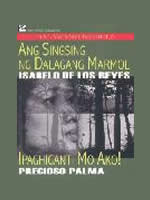
Ipaghiganti Mo Ako...! is a 1914 Tagalog-language novel written by Filipino novelist and dramatist Precioso Palma. The 207-page book was published in Manila by Limbagang Banahaw during the American era in Philippine history (1898-1946). The 1914 version of the novel has an afterword written by Julian C. Balmaceda.

Anino ng Kahapon is a 1907 Tagalog-language novel written by Filipino novelist Francisco Laksamana. The 294-page novel was published in Manila by Santiago L. Abillar and SP during the first few years of American period in Philippine history. The 1907 version was illustrated by P Imperial. The novel was republished by the Ateneo de Manila University Press in 2002. According to the Ateneo de Manila University Press, the novel was written by Laksamana to help provide the readers with a "nostalgic recollection of the period of mournful Filipinoness". According to literary critic Epifanio San Juan, Jr. — apart from being a historical and political novel — Anino ng Kahapon was one of the romance novels and novels about heroic Philippine characters produced by Filipino authors from 1900 to contemporary times.
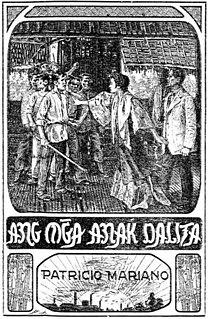
Ang mga Anak Dalita is a 1911 Tagalog-language novel written by Filipino novelist Patricio Mariano. The 73-page novel was published in Manila by Limbagan at Aklatan Ni I.R. Morales during the American era in Philippine history (1898–1946). Ang mga Anak Dalita is a political novel that deals also with Filipino ideology, the socio-economic situation, the industrial upheaval, and the struggle of the oppressed Filipino working class in Manila during Mariano’s time.
Ang Lihim ng Isang Pulo: Nobelang Tagalog – "The Secret of an Island: A Tagalog Novel " – is a Tagalog-language novel written in 1926 by Filipino novelist Faustino S. Aguilar. The 353-page novel was first published by Sampaguita Press in the Philippines in 1927. It was republished in Manila by Benipayo Press in 1958.
The Southern Tagalog 10 was a group of activists abducted and "disappeared" in 1977 during martial law in the Philippines under Proclamation No. 1081 issued by President of Philippines Ferdinand E. Marcos. Of the 10 university students and professors who were abducted, only three "surfaced" later after being killed by suspected agents of the state. Two of those who surfaced were apparently summarily executed. The rest were never found.
E. San Juan, Jr. . 2019. "Kwalta, Ang Sagradong Puta, Pagwawaldas: Politiken Sekswal sa BUSABOS NG PALAD," DILIMAN GENDER REVIEW, 2019. University of the Philippines Journal. Critical interpretation of Aguilar's novel.
